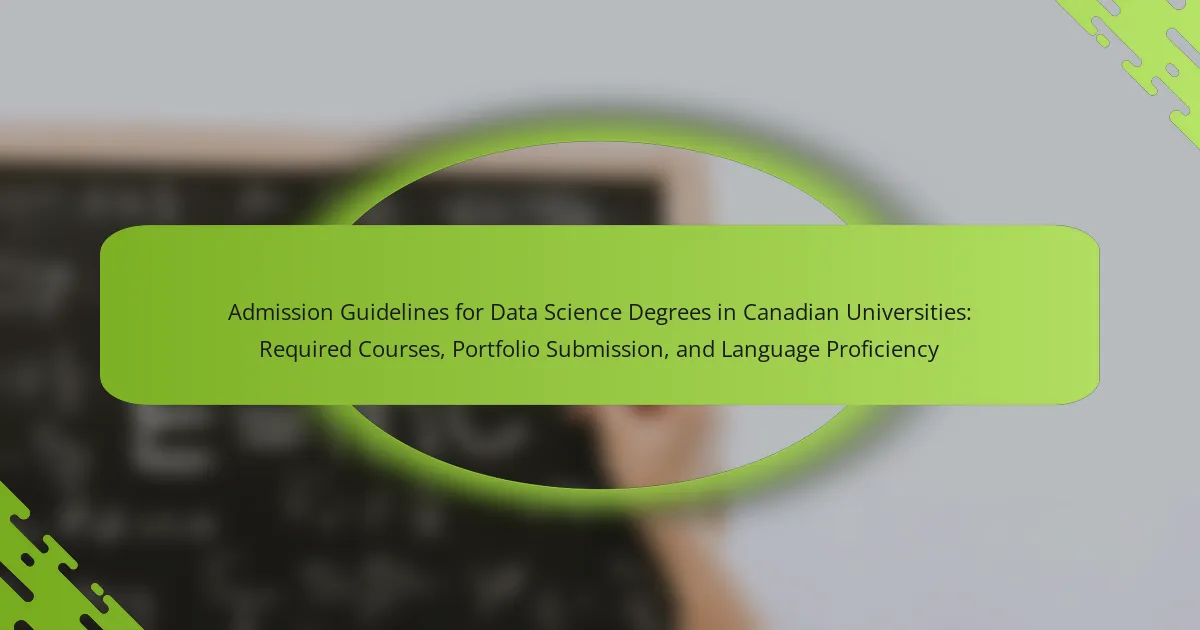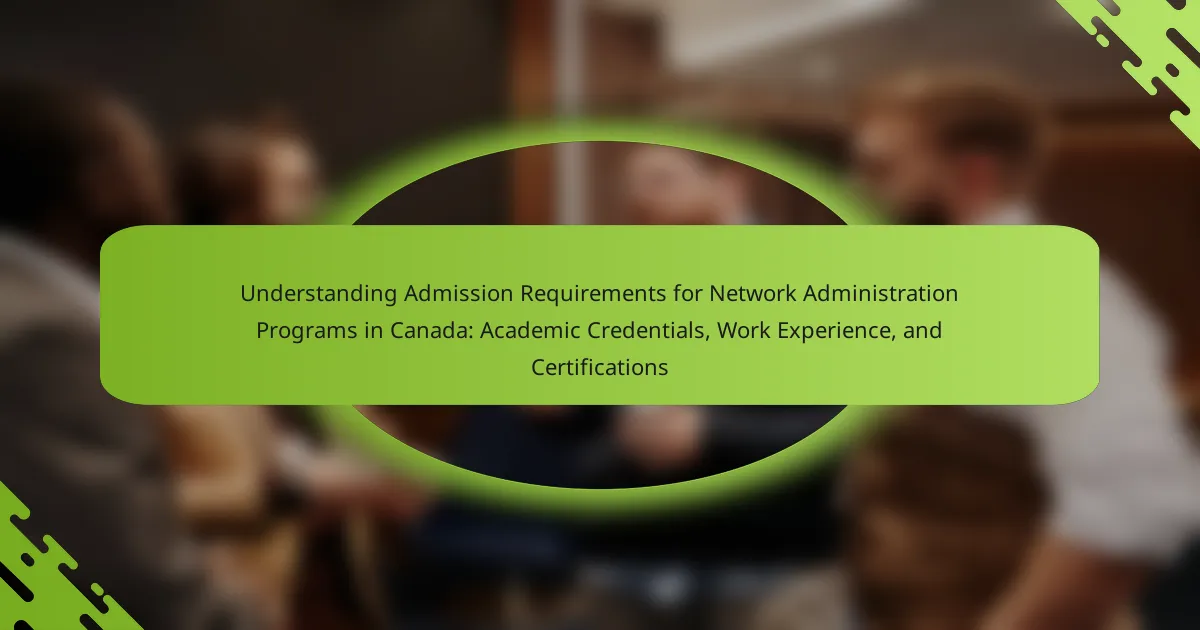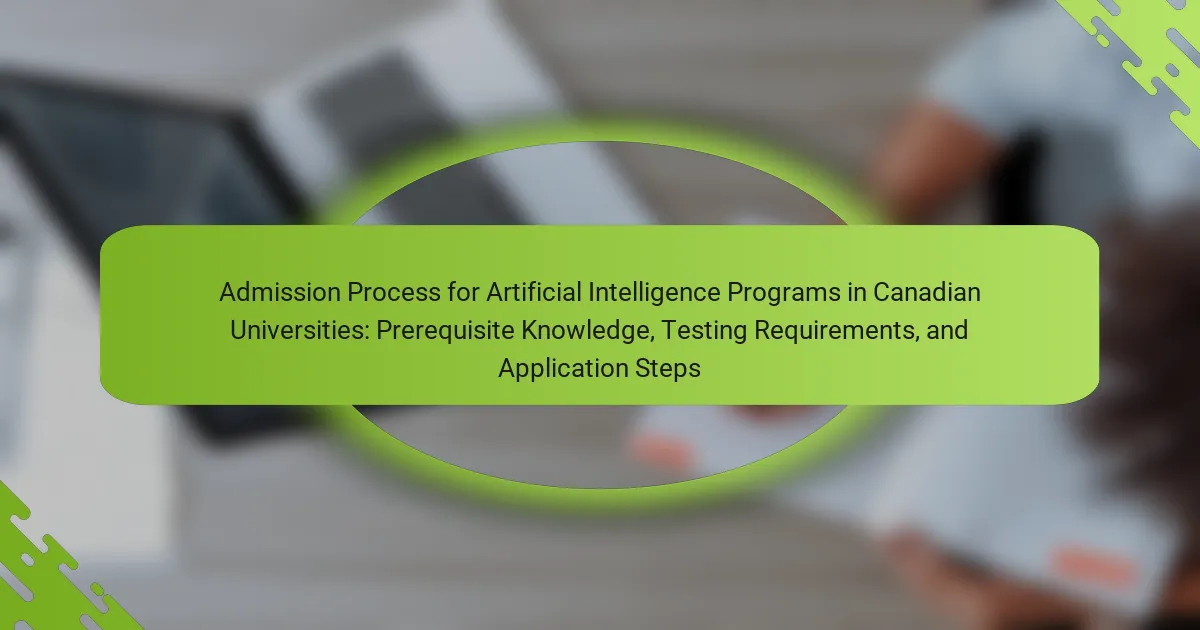The article focuses on the admission criteria for Information Technology degrees in Canada, detailing the academic qualifications, required documentation, and application deadlines. Key requirements typically include a secondary school diploma with a minimum average of 65% in core subjects, often mandating mathematics. Applicants may also need to submit standardized test scores, transcripts, letters of recommendation, and personal statements. The article highlights the variability in admission standards across institutions, including differences in prerequisite courses and documentation requirements, as well as the challenges faced by applicants in navigating these processes and meeting deadlines.
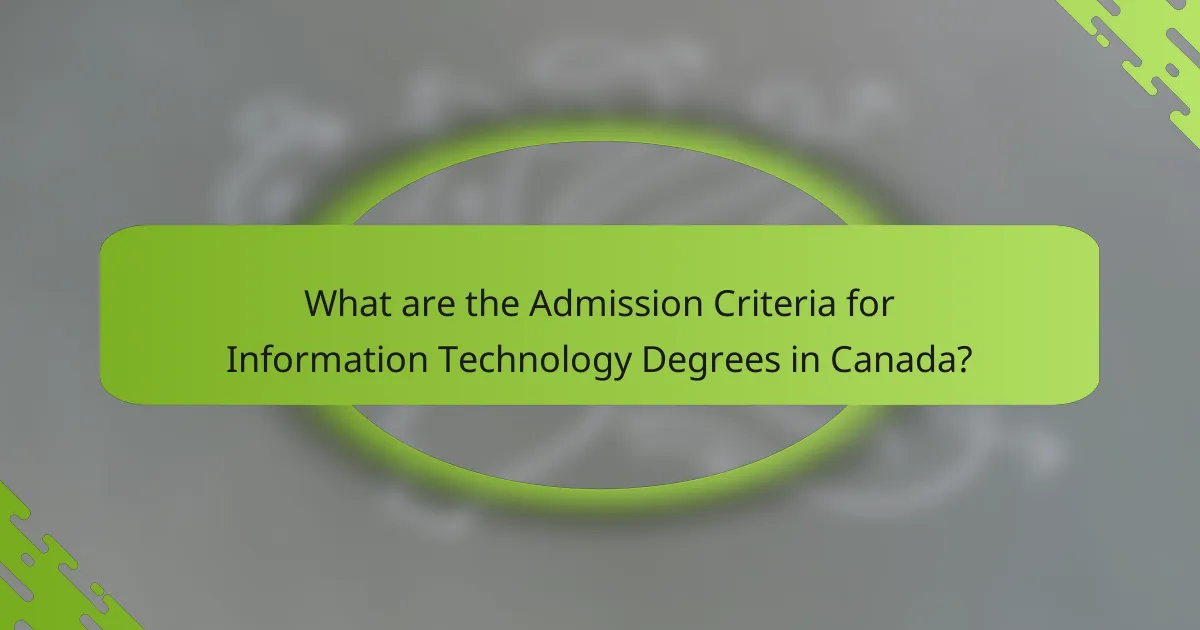
What are the Admission Criteria for Information Technology Degrees in Canada?
Admission criteria for Information Technology degrees in Canada typically include a secondary school diploma or equivalent. Most institutions require a minimum average of 65% in core subjects. Mathematics is often a mandatory subject for eligibility. Some programs may also require specific courses in computer science or technology.
In addition to academic qualifications, applicants usually need to submit standardized test scores, such as the SAT or ACT, depending on the institution. Required documentation often includes transcripts, letters of recommendation, and a personal statement.
Deadlines for applications vary by institution, with many requiring submissions by early spring for fall admission. It’s essential for applicants to check specific requirements for each program, as they can differ.
What academic qualifications are required for admission?
Academic qualifications for admission to Information Technology degrees in Canada typically include a high school diploma or equivalent. Applicants often need to have completed specific courses, such as mathematics and computer science. Some programs may require a minimum average grade, often around 70% or higher. Additionally, post-secondary qualifications may be considered for transfer students. Proof of English language proficiency may also be necessary for non-native speakers. These requirements can vary by institution, so it is essential to check specific program guidelines.
What specific high school courses are necessary for applicants?
Applicants for information technology degrees in Canada typically need to complete specific high school courses. Required courses generally include mathematics, specifically calculus and algebra. English language proficiency is also essential, often demonstrated through an English course. Additionally, courses in computer science or information technology are highly recommended. Some programs may require physics as well. These courses provide foundational knowledge necessary for success in IT programs. The combination of these subjects supports the development of critical thinking and technical skills vital for the field.
How do post-secondary education credentials impact eligibility?
Post-secondary education credentials significantly impact eligibility for admission to Information Technology degree programs in Canada. These credentials serve as proof of a candidate’s academic preparedness. Most institutions require a minimum level of education, typically a high school diploma or equivalent. In many cases, specific courses in mathematics and computer science are also prerequisites. Higher-level credentials, such as diplomas or degrees in related fields, can enhance a candidate’s application. Institutions often assess the relevance and rigor of these credentials during the admission process. For example, a degree in computer science may provide an advantage over a general studies diploma. Statistics show that applicants with relevant post-secondary education have higher acceptance rates.
What documentation is needed for the application process?
The documentation needed for the application process includes academic transcripts, proof of English language proficiency, and letters of recommendation. Academic transcripts must show completed courses and grades. Proof of English language proficiency can be demonstrated through tests like IELTS or TOEFL. Letters of recommendation should come from teachers or employers familiar with the applicant’s abilities. Some programs may also require a personal statement or resume. Each institution may have specific requirements, so it is essential to check their guidelines.
What forms of identification must be submitted?
Applicants must submit government-issued photo identification. This identification verifies the applicant’s identity. Acceptable forms include a passport, driver’s license, or national ID card. Each form must clearly display the applicant’s name and photo. Institutions may also require additional documentation, such as proof of residency. These requirements ensure compliance with admission standards. Specific institutions may have unique identification requirements. Always check the individual program guidelines for exact details.
How should transcripts be prepared and submitted?
Transcripts should be prepared by obtaining official copies from the issuing institution. These copies must include the institution’s seal or signature for authenticity. Ensure that transcripts are in English or French; otherwise, certified translations are required. Submit transcripts directly to the designated admissions office of the institution. Some institutions may accept electronic transcripts sent through secure systems. Verify submission deadlines to ensure timely processing. Accurate and complete transcripts are critical for application evaluation.
What are the deadlines for applying to Information Technology programs?
Deadlines for applying to Information Technology programs vary by institution. Most Canadian colleges and universities have application deadlines ranging from January to March for September intakes. Some institutions may also offer winter or spring intakes with deadlines in the preceding months. Specific dates can differ based on the program and institution. It’s essential to check the official website of each institution for precise deadlines. This ensures that applicants have the most accurate and up-to-date information.
When do applications typically open and close?
Applications for Information Technology degrees in Canada typically open in the fall, around October. They usually close by the end of the following winter, often in February or March. Specific deadlines can vary by institution. Most programs adhere to this general timeline to align with academic year schedules. Checking individual university websites is essential for precise dates.
What are the implications of missing application deadlines?
Missing application deadlines can result in disqualification from the admissions process. Applicants may lose the opportunity to enroll in their desired program. Many institutions do not accept late applications, which limits options. This can lead to a delay in starting education or pursuing career goals. Additionally, missing deadlines may affect financial aid eligibility. Some scholarships and grants require timely applications. This can increase financial burden if students must wait another year to apply. Overall, missing application deadlines can severely impact academic and career trajectories.
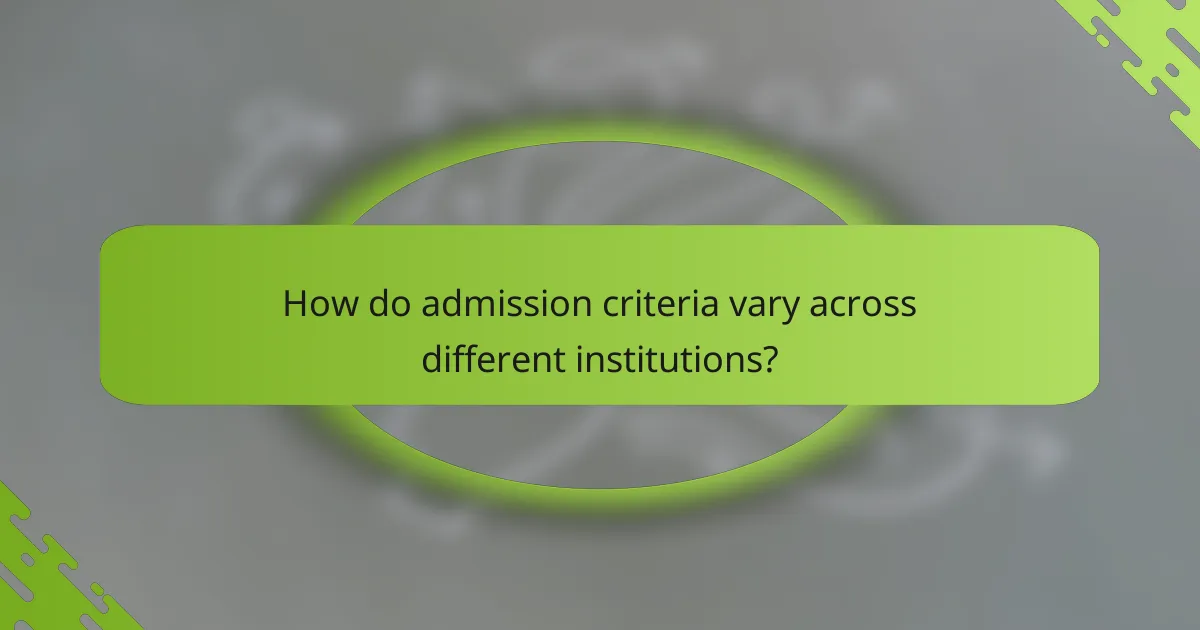
How do admission criteria vary across different institutions?
Admission criteria vary across different institutions in Canada based on academic qualifications, required documentation, and deadlines. Each institution sets its own standards for GPA, prerequisite courses, and standardized test scores. Some schools may require a minimum overall average, while others focus on specific subjects like mathematics or computer science. Documentation requirements also differ; some institutions may ask for letters of recommendation, while others may not. Application deadlines can vary significantly, with some institutions having rolling admissions and others adhering to strict cut-off dates. This diversity reflects the unique mission and academic focus of each institution, catering to a range of student profiles and educational goals.
What are the differences in requirements between universities and colleges?
Universities and colleges have different admission requirements. Universities typically require higher academic qualifications, such as a high school diploma with specific course prerequisites. Colleges may accept a broader range of qualifications, including general high school diplomas.
Universities often require standardized test scores, such as the SAT or ACT, while colleges may not. The application process for universities usually includes more extensive documentation, such as letters of recommendation and personal statements. Colleges tend to have simpler application processes with fewer required documents.
In Canada, universities often look for higher average grades compared to colleges. This reflects their focus on more specialized and research-oriented programs. Colleges generally emphasize practical skills and may prioritize work experience or portfolios over academic performance.
These differences highlight the varying educational focuses of universities and colleges.
How do admission standards differ for competitive programs?
Admission standards for competitive programs are typically higher than for non-competitive programs. Competitive programs often require a minimum GPA that is above the general admission threshold. They may also necessitate standardized test scores, such as the SAT or ACT, which are not always required for other programs. Additionally, competitive programs frequently look for relevant work experience or extracurricular activities that demonstrate a candidate’s commitment and skills. Applicants may also need to submit a personal statement or portfolio that highlights their achievements and motivations. This rigorous selection process ensures that only the most qualified candidates are admitted. For example, some technology programs in Canada may require a GPA of 3.5 or higher, while less competitive programs may accept students with a GPA of 2.5.
What unique attributes do certain institutions seek in applicants?
Certain institutions seek unique attributes such as leadership potential, innovative thinking, and community involvement in applicants. Leadership potential is often assessed through past experiences in team settings or extracurricular activities. Innovative thinking is evaluated through problem-solving skills demonstrated in academic projects or personal initiatives. Community involvement reflects a candidate’s commitment to social responsibility and is shown through volunteer work or participation in community service. These attributes align with the institutions’ goals of fostering well-rounded individuals who can contribute positively to society and the technology field.
How can applicants improve their chances of acceptance?
Applicants can improve their chances of acceptance by meeting and exceeding admission criteria. They should maintain a strong academic record, particularly in relevant subjects like mathematics and computer science. High standardized test scores can enhance their profiles as well.
Additionally, applicants must submit all required documentation accurately and on time. This includes transcripts, letters of recommendation, and personal statements. Tailoring the personal statement to reflect passion for information technology can make a significant impact.
Participation in extracurricular activities related to technology also demonstrates commitment and skills. Engaging in relevant work experience or internships can further strengthen an application.
Research indicates that applicants who showcase a clear understanding of the program and its requirements tend to be favored. Thus, thorough preparation and attention to detail are crucial for improving acceptance chances.
What extracurricular activities are valued by admissions committees?
Admissions committees value extracurricular activities that demonstrate leadership, commitment, and teamwork. Participation in clubs, sports, and community service highlights these qualities. Leadership roles in student government or organizations are particularly noteworthy. Academic clubs related to technology show a passion for the field. Volunteering experiences reflect social responsibility and initiative. Research indicates that 85% of admissions officers consider extracurriculars important for holistic evaluation. Engaging in diverse activities can enhance a candidate’s profile significantly.
How can personal statements enhance an application?
Personal statements enhance an application by providing a unique insight into the applicant’s motivations and goals. They allow candidates to express their individual experiences and perspectives. This personal touch can differentiate applicants in a competitive field. Admissions committees often seek candidates with passion and commitment. A well-crafted personal statement can showcase relevant skills and knowledge. It can also highlight the applicant’s fit for the specific program. Research indicates that strong personal statements positively influence admission decisions. For instance, a study by the Journal of College Admission found that 80% of admissions officers consider personal statements crucial in evaluating applicants.
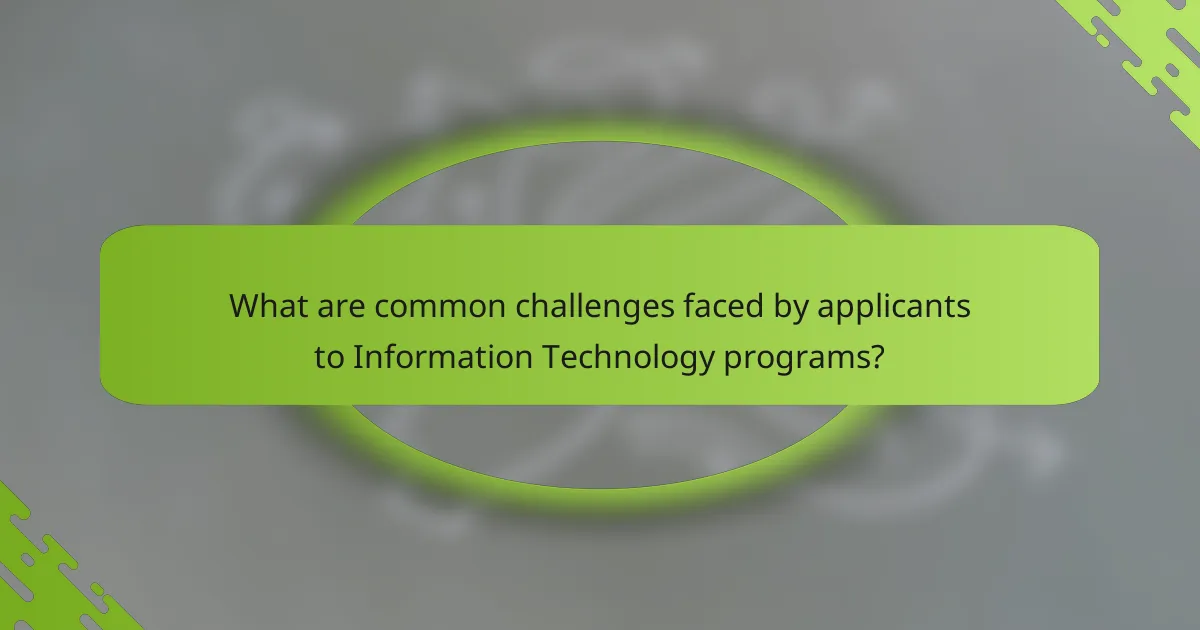
What are common challenges faced by applicants to Information Technology programs?
Common challenges faced by applicants to Information Technology programs include meeting academic prerequisites and preparing required documentation. Many programs demand specific high school courses, which can limit eligible candidates. Applicants often struggle to gather all necessary documents, such as transcripts and recommendation letters, within tight deadlines. Additionally, competition is intense, making it difficult for some to stand out. Financial constraints can also hinder access to resources, such as test preparation or application fees. Furthermore, applicants may lack familiarity with the application process, leading to errors or incomplete submissions. These challenges can ultimately affect their chances of admission into desired programs.
What obstacles do international students encounter during the admission process?
International students encounter several obstacles during the admission process. Language barriers can hinder effective communication with institutions. Different educational systems may lead to confusion regarding equivalency of qualifications. Financial constraints often complicate the ability to pay tuition and living expenses. Visa regulations can create delays and uncertainties in the application timeline. Limited access to information about specific admission requirements can lead to incomplete applications. Cultural differences may affect students’ understanding of the application process. Additionally, varying deadlines across institutions can create challenges in planning. These factors collectively impact the overall admission experience for international students.
How can language proficiency requirements affect admission chances?
Language proficiency requirements can significantly affect admission chances for prospective students. Institutions often mandate specific language tests, such as TOEFL or IELTS, to assess applicants’ English skills. Meeting or exceeding these requirements can enhance a candidate’s application. Conversely, failing to meet language proficiency standards may result in automatic rejection.
Research shows that students with higher language proficiency tend to perform better academically. According to a study by the Canadian Bureau for International Education, effective communication skills correlate with academic success in Canadian institutions. Thus, language proficiency not only influences admission decisions but also impacts overall student performance and retention rates.
What support resources are available for international applicants?
International applicants can access various support resources during their admission process. Many Canadian institutions offer dedicated international student offices. These offices provide guidance on visa applications and cultural adjustment. Additionally, universities often have online resources and FAQs tailored for international students. Many institutions also host orientation programs specifically for international applicants. These programs help familiarize students with academic expectations and campus life. Furthermore, mentorship programs pair new international students with current students. This peer support can ease the transition to studying in Canada. Lastly, financial aid and scholarship information is also available for international applicants.
What are the best practices for submitting a successful application?
The best practices for submitting a successful application include thorough preparation and attention to detail. Applicants should carefully review the admission requirements for their chosen program. They must gather all necessary documentation, such as transcripts and letters of recommendation. Submitting a well-written personal statement is crucial. This statement should clearly articulate the applicant’s motivation and relevant experience. Additionally, applicants should ensure that all materials are submitted before the deadline. Following the specific application format outlined by the institution is essential. Finally, confirming the receipt of the application can help prevent any potential issues. These practices increase the likelihood of a successful application.
How can applicants ensure their documentation is complete and accurate?
Applicants can ensure their documentation is complete and accurate by carefully reviewing each requirement. They should create a checklist of all necessary documents. This includes transcripts, letters of recommendation, and personal statements. Applicants must verify that all documents meet the institution’s specific guidelines. They should check for correct formatting, required signatures, and submission deadlines. Additionally, applicants can seek feedback from mentors or advisors. This helps identify any missing information or errors. Finally, double-checking each document before submission minimizes mistakes. Following these steps significantly increases the likelihood of submitting complete and accurate documentation.
What tips can help applicants meet deadlines effectively?
Applicants can meet deadlines effectively by creating a detailed timeline. This timeline should outline all important dates and tasks. Break larger tasks into smaller, manageable steps. Prioritize these tasks based on their deadlines. Use digital tools or apps to set reminders for each task. Regularly review progress to stay on track. Minimize distractions during work sessions to enhance focus. Seek assistance or clarification on requirements early to avoid last-minute confusion.
The main entity of the article is the admission criteria for Information Technology degrees in Canada, which encompasses academic qualifications, required documentation, and application deadlines. The article outlines essential prerequisites such as secondary school diplomas, specific high school courses like mathematics and computer science, and the necessity of standardized test scores. It details the documentation required for applications, including transcripts and letters of recommendation, and emphasizes the importance of adhering to varying deadlines set by different institutions. Additionally, the article discusses the challenges applicants may face, particularly international students, and offers best practices for submitting a successful application.

